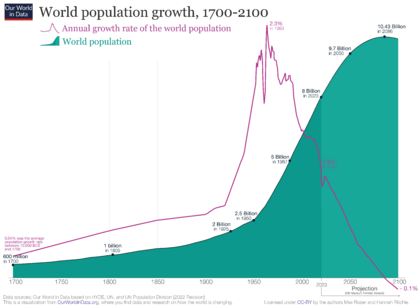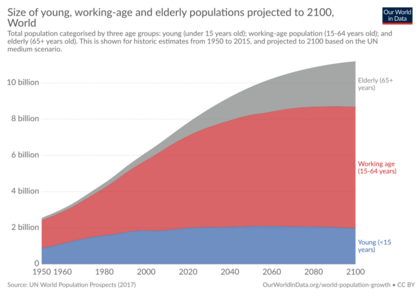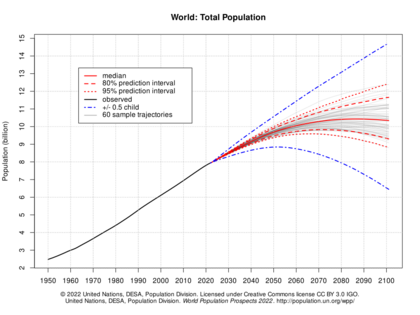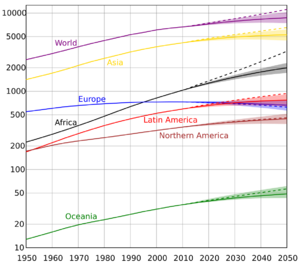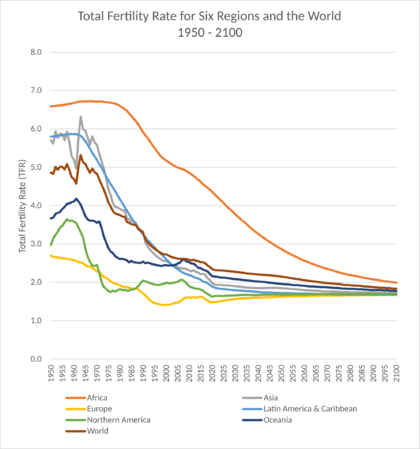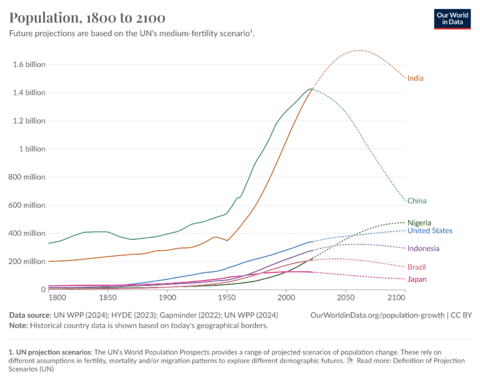Human population projections facts for kids
Human population projections are educated guesses about how the number of people on Earth will change in the future. Scientists use these predictions to understand how our growing population might affect the planet and our lives. They look at current trends in human life, like how many babies are born and how long people live, to forecast what will happen next.
These models use information about how things like money, society, and technology change birth and death rates. This helps them predict how the world's population will grow or shrink over time.
The United Nations (UN) made a projection in 2022. It showed that the world's population is growing more slowly than it used to. The fastest growth was in 1963. As of 2023, the population was 8 billion people. The UN thinks the population will reach a peak of about 10.3 billion people around the year 2084 and then slowly start to decrease. This guess is based on the idea that families around the world will have fewer children on average.
However, other experts think the population might peak sooner, maybe between 2060 and 2070. They believe that better education and family planning could lead to lower birth rates more quickly.
The UN also predicts that most of the population growth between now and 2050 will happen in less developed countries, especially in Africa. In fact, they believe the population of sub-Saharan Africa will double by 2050.
Contents
How Are Population Predictions Made?
To guess future population numbers, experts, called demographers, look at three main things: how many people are born, how many people die, and how many people move from one country to another.
Births (Fertility)
Fertility is the average number of children a woman has in her lifetime. This is the biggest factor in long-term population change. In the past, it was common for women to have five or more children.
Today, the world average is about 2.1 children per woman. Experts believe this number will continue to drop. In places where the birth rate is already low, like Europe, it might rise slightly. In places where it is high, it is expected to fall.
Deaths (Mortality)
The death rate, or mortality rate, also affects population. When people start living longer, it can cause the population to grow. Over the past few decades, people all over the world have started living much longer lives.
Global life expectancy (the average age a person is expected to live to) has risen from 48 years in the 1950s to over 70 years today. It is expected to keep rising, reaching about 83 years by 2100. This is thanks to better healthcare and fewer childhood diseases.
Moving (Migration)
Migration is when people move from one country to live in another. This can cause the population of some countries to grow and others to shrink.
For example, between 2010 and 2020, some countries saw millions of people move in. This was often because of job opportunities or to escape unsafe conditions at home. For countries like Japan and Italy, where more people die than are born, migration helps to slow down population loss.
World Population in the Future
So, what does all this mean for the world's population? Let's look at the predictions for the near future and the end of the century.
What to Expect by 2050
The UN predicts that by 2050, the world population will be about 9.7 billion people. The pie charts and table below show how the population is expected to change on each continent.
Notice how Africa's share of the world population is predicted to grow a lot, while Europe's share will shrink.
| 2000 | 2050 | Growth | |
|---|---|---|---|
| Asia | 3.72 | 5.28 | +42% |
| Africa | 0.82 | 2.47 | +201% |
| Europe | 0.73 | 0.70 | -4% |
| Latin America & the Caribbean | 0.52 | 0.73 | +40% |
| Northern America | 0.31 | 0.43 | +39% |
| Oceania | 0.03 | 0.06 | +100% |
| World | 6.13 | 9.66 | +58% |
|
2000 Africa (820180%) Asia (3721978%) Europe (728105%) Latin America and the Caribbean (517614%) Northern America (310954%) Oceania (31112%) |
2050 Africa (2466648%) Asia (5280378%) Europe (703028%) Latin America and the Caribbean (730057%) Northern America (426580%) Oceania (57688%) |
| UN estimates for world population by continent in 2000 and in 2050 (pie chart size to scale): Asia Africa Europe Latin America Northern America Oceania |
|
What to Expect by 2100
Looking even further ahead, the UN predicts the world's population will peak at 10.4 billion people in 2086. After that, it will slowly decline.
Other groups have different ideas.
- A study in The Lancet medical journal suggests the population will peak earlier, in 2064, at 9.7 billion people. They believe this will happen because of more education and rights for women.
- The Wittgenstein Center in Austria predicts a peak of 9.4 billion people around 2070.
These different predictions show how hard it is to be certain about the distant future. Small changes in birth rates can make a big difference over many decades.
Where Will Population Grow the Most?
Almost all of the world's population growth is expected to happen in Africa and Asia. Africa's share of the global population is predicted to grow from 17% today to 38% by 2100. This is partly because Africa has a very young population, with many people who are just starting to have families.
The population of more developed regions, like Europe and North America, is expected to stay about the same or even shrink.
The table below shows the 15 countries that are predicted to have the largest populations in 2050 and 2100. Notice how the rankings change over time. Countries like Nigeria and the Democratic Republic of the Congo are expected to move up the list.
| Country | Population (millions) | Rank | ||||
|---|---|---|---|---|---|---|
| 2024 | 2050 | 2100 | 2024 | 2050 | 2100 | |
| India | 1,451 | 1,680 | 1,505 | 1 | 1 | 1 |
| China | 1,419 | 1,360 | 633 | 2 | 2 | 2 |
| Pakistan | 251 | 372 | 511 | 5 | 4 | 3 |
| Nigeria | 233 | 359 | 477 | 6 | 5 | 4 |
| Democratic Republic of the Congo | 109 | 218 | 431 | 15 | 8 | 5 |
| United States | 345 | 381 | 421 | 3 | 3 | 6 |
| Ethiopia | 132 | 225 | 367 | 10 | 7 | 7 |
| Indonesia | 283 | 320 | 296 | 4 | 6 | 8 |
| Tanzania | 69 | 130 | 263 | 22 | 15 | 9 |
| Bangladesh | 174 | 215 | 209 | 8 | 10 | 10 |
| Egypt | 117 | 162 | 202 | 13 | 11 | 11 |
| Brazil | 212 | 217 | 163 | 7 | 9 | 12 |
| Angola | 38 | 74 | 150 | 42 | 27 | 13 |
| Sudan | 50 | 85 | 137 | 30 | 21 | 14 |
| Mexico | 131 | 149 | 130 | 11 | 12 | 15 |
The eight countries in bold are expected to be responsible for about half of the world's population growth by 2050.
See also
- Population growth
- Human overpopulation
- List of sovereign states and dependencies by total fertility rate


